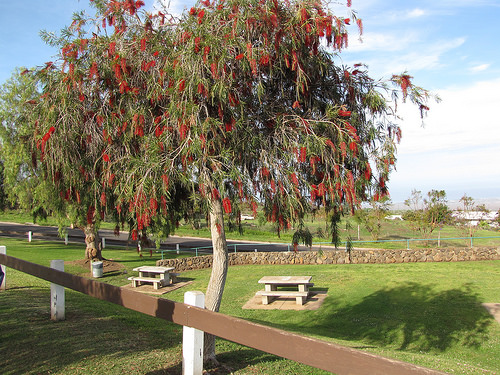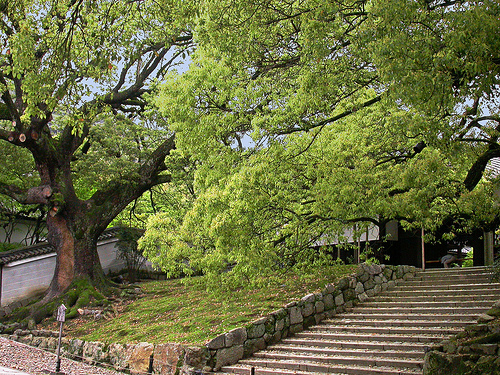Evergreen Trees For Median

Gardening Question from Lena:
We live in Harbor City, CA. The majority of the trees planted on the median are I think some form of a pepper tree. The roots are invasive to plumbing not to mention the sidewalks. Where occasionally LA city comes around as slaps black top on the sidewalks to cover the cracks that were caused by the roots of the trees. Anyway we removed the tree and are wanting to plant a new tree and are considering a camphor. What are your thoughts or suggestions.

Photo by john weiss 
Answer from Pat:
When choosing a street tree one needs to take into consideration the space available for roots. I am unclear about the space available for the new tree, but since you said a pepper tree had torn up sidewalks and gotten into plumbing it sounds as if you are talking about a tree for the parking strip on the side of the sidewalk and not a tree for a median dividing the lanes in the middle of the street. At any rate, if a pepper tree didn’t work neither will a camphor tree which has many surface roots.
Camphor trees (Cinnamomon camphora) are handsome, spreading, rounded, evergreen shade trees that grow slowly to from 20 to 40 feet, needing pruning every 3 years or so. They do drip however and they have many surface roots. They are excellent shade trees for parks, parkways, gardens without sidewalks, and larger spaces where they can survive many years. They are not good choices for smaller medians or parking strips where they will make for problems—the same problems you had with either species of pepper trees.
For parkways and medians measuring 5 to 6 feet, or 5X5 cutouts, I would recommend the following evergreen trees: Weeping bottlebrush (), which brings birds; Cape chestnut (Callodendrum capense), which has lovely flowers in spring or early summer, not good too close to coast but blooms well a few blocks inland and is a very beautiful tree; Cider gum (Eucalyptus gunnii); Pink or red ironbark (E. syderoxylon) which has lovely flowers; Australian willow (Geijera parviflora) is drought resistant and easy to grow; New Zealand Christmas tree (Metrosideros excelsa) has lovely flowers and can take ocean wind; Victorian box (Pittosporum undulatum) is trouble free and easy to grow with fabulously fragrant flowers in spring but sticky fruit drips in fall. Another possibility is jacaranda (Jacaranda acutifolia, J. mimosifolia) but keep it away from ocean wind or it won’t bloom. It needs reflected heat. It is a bit messy and it is not evergreen, but—wow—it’s beautiful in bloom! A row of these lining a street is a breathtaking sight. Once again, though, I emphasize this glory of bloom simply will not happen in a cold ocean breeze. In order to perform their best, jacaranda trees must be grown in interior heat or if grown near the coast they must be completely protected from ocean wind by buildings on the west.
For parking strips between the street and the sidewalk measuring 3 to 5 feet or 3X 3 cutouts, I recommend the following evergreen trees: Peppermint tree (Agonis flexuosa) one of the best, easiest, and most disease resistant of trees; lemon bottle brush (Callistemon citrinus) a bit messy but lovely and brings birds. Be sure to get a good hybrid variety. Blooms in waves year round. Bronze loquat (Eriobotra deflexa) I don’t personally like it but it’s easy and clean; Sweet shade (Hymenosporum flavum). This has drop-dead wonderful fragrance from all-over small, yellow flowers in spring or early summer. Very narrow upright tree can be planted in groves or in a narrow side yard between buildings.
For 2 to 3-foot parkways or 2 foot cutouts, I recommend the following evergreen trees: Indian hawthorne tree (Rhaphiolepis ‘Magestic Beauty’) This tree is simply the best, easiest, most beautiful, and cleanest small street or patio tree available. No problems. It grows in a natural umbrella shape. Always buy the real thing with a Monrovia label on it and get one with the tallest trunk available. Prune it only once a year by shearing all over the top to cut off some of the foliage along with all the spent flowers and berries. After pruning the tree should be left in the shape of an umbrella and will be a little larger each year. This pruning should be done in June AFTER, but NEVER BEFORE, bloom. Blooms with pink flowers in spring that become deeper pink as the tree grows larger and older. Don’t let them prune it in fall or there will be no bloom! Finally for a taller tree: Brisbane box (Lophostemon confertus,Tristania conferta) one of the best street and lawn trees. Prune when young for rounder shape of head.
Photo by Starr Environmental 

